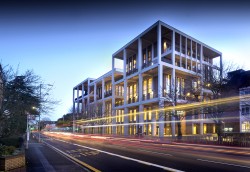With a mission statement of ‘purpose beyond profit’, Willmott Dixon has long adopted innovative techniques to improve the built environment. Using offsite construction, they are improving productivity and quality with Town House at Kingston University.
From addressing the climate emergency to tackling labour shortages, the construction industry has its fair share of challenges to confront to ensure it’s suitably equipped to handle our growing population and meet the associated infrastructure demands.
Advances in technology in recent years have meant that offsite construction are paving the way for solving these issues. As well as Building Information Modelling (BIM), offsite construction has become increasingly popular. Although currently it only accounts for 12 to 15% of new construction activity, it is expected to see a 30% year-on-year increase.
Willmott Dixon has extensive experience in offsite manufacturing having used it in most sectors including housing, healthcare, offices, retail and leisure. This has included lightweight steel and timber frame, factory-assembled bathrooms or pods, cross laminated timber (CLT) and precast concrete. To date, it has successfully delivered over 7,000 light gauge steel frame and timber frame units. These have included projects being programmed and built around 20 to 30% faster than traditional construction, a reduction in heating bills thanks to high thermal performance and airtightness and high quality internal finishes due to the accuracy of the factory assembly process.
However, housing is just one area where it has seen a positive impact from utilising offsite construction methods. ‘Bespoke designs’ are also receiving Willmott Dixon’s offsite construction treatment. One such project where it has paid dividends for the company was its recently completed project for Kingston University – Town House. The vision was to create a front door to the community and replace Kingston University’s old, 3000sq m pre-fabricated temporary meeting and office space on Penrhyn Road with a 9400sq m bespoke, landmark building that complemented nearby architecture and was entirely sympathetic to its surroundings. Utilising a precast concrete frame, the design, which is reflective of the external cloisters seen in Northern European architecture, features open spaces and high ceilings with more than 50% of the accommodation open plan.
“The precast concrete frame is integral to Town House’s design,” says Tony Mingoia, Senior Operations Manager at Willmott Dixon and who led the project. “Exposed concrete runs throughout the entirety of the building and there are no surface fixings meaning it is open to close scrutiny. Precision and perfection were paramount – there was no room for blemishes or air pockets, which would have ruined the sleek finish. This was one of the reasons behind using precast concrete rather than cast in-situ reinforced concrete.
“Initially we looked at how we could work around the design. There were a lot of constraints on site as it is quite a small plot. We recognised quite early on that using precast concrete was the best way forward for the frame. Normally, one of the factors that helps sway the decision to use precast concrete is the amount of repetition through the design. Aside from the beam and column section size, there is very little repetition at Town House.
“Ductwork for services, pipes, cables and communications is cast within each structural member. There are hardly any two sections that are exactly the same. The goodwill of our neighbours, avoiding disturbing residents and the day-to-day working of the University, as well as the speed of erection, were also attractive benefits of the precast solution.”
Effective collaboration with the supply chain is a huge contributing factor to a successful outcome for offsite construction methods. “BIM was a key component to creating Town House,” adds Tony. “We wanted this project to be BIM Level 2 and fortunately our supply chain really embraced this to great benefit. Fortnightly design meetings were held between precast frame supplier PCE and mechanical and electrical specialists DES Group and CMB Engineering. Together the team was able to incorporate the completed M&E design within the frame immediately. These meetings continued throughout construction to manage clash detection.”
Willmott Dixon’s trusted supply chain partners are key to its drive to continue using offsite construction as much as possible. It works closely with manufacturers which fabricate the product components in factories, as well as specialist contractors with the expertise to assemble them on site.
“We have the expertise in house to advise on project feasibility, design, and potential cost, plus all relevant regulations and standards involving offsite manufacturing but the whole supply chain has to be on board for it to work,” says Tony. “This one team approach is essential to reaping the rewards that offsite manufacturing brings, including speed of construction, accurate costs, higher quality, better safety and, ultimately, a more sustainable approach to construction across the industry.”
For more information visit: www.willmottdixon.co.uk/expertise/off-site-manufacturing
To view the article and the complete magazine please click here









